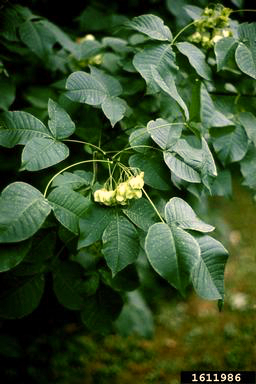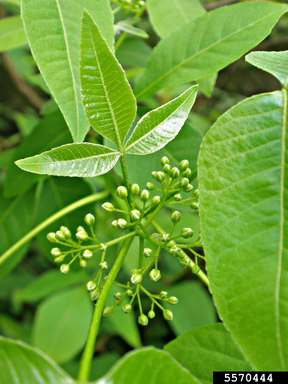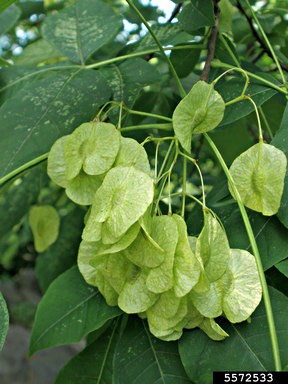Natives to Know: Hoptree, Ptelea trifoliata
By Joyce Tuharsky, Wild Ones member
Hoptrees are fairly common, small understory trees or shrubs, that are native to the eastern U.S and southern Canada, including Michigan. The trunks are slender and crooked; the branches are interwoven. Hoptrees can grow up to 25 feet tall, with a broad, rounded 15–20-foot crown.
The leaves of Hoptrees are a dark glossy green, alternate, and trifoliate. They are composed of three ovate leaflets, each 3–5 inches long and pointed at the apex. These leaves turn a pretty greenish-yellow or gold in autumn. Hoptree bark is smooth, gray to reddish brown in color, with short horizontal corky ridges. The wood is yellow brown, close-grained, hard, and satiny.
Clusters of small greenish-white flowers appear on the Hoptree in the late spring—each flower about an ½ inch across, with 4–5 narrow petals. The flowers give off an aromatic scent. Actually, the entire tree (bark, foliage, and twigs) gives off a lemony musky odor when crushed.



Another common name for the Hoptree is Wafer ash. This name comes from the flat, papery, wafer-like fruits that appear on the tree after the flowers fade. About 1 inch across and containing two seeds apiece, these wafers ripen in October and are held high on the tree until winter winds shake them loose. Hoptree is not an ash however. It is the most northerly occurring species of the Rue (Citrus) family. Because the wafers have a bitter taste, they have been used as a substitute for hops in brewing beer.
If you want to draw pollinators to your yard, the Hoptree is a great species! The sweet nectar of the blossoms attracts many species of bees and butterflies. The tree is also a larval host to several caterpillars—including that of the Giant Swallowtail, our largest butterfly. Hoptrees provide shelter for birds and mammals, and wildlife love to eat the wafers. At the same time, this species is deer resistant.
In nature, Hoptrees tend to blend into the green background of a forest. But when placed on its own in a yard or garden, a Hoptree is quite handsome. With its ornamental blossoms, wafers, and fall color, it makes a great accent tree. On the other hand, Hoptrees can be pruned/shaped to become a dense, rounded shrub that will nicely fill a corner or boundary edge.
Slow growing and requiring minimal maintenance, Hoptrees will adapt to a variety of soils. Because they are an understory species, they grow well in dappled sunlight and prefer moist but well-drained locations. In sunny/hot locations, a Hoptree may require watering during dry spells. Harsh afternoon sun can scorch its foliage. Propagate by stratified seed or softwood cuttings.
Photos left to right:
1. John Ruter, University of Georgia, Bugwood.org
2. & 3. Ansel Oommen, Bugwood.org
